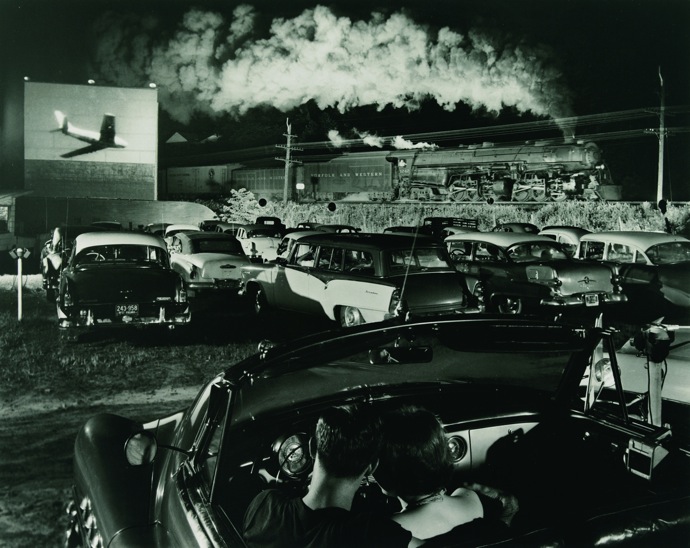Jan 4, 2010 0
O. Winston Link, Hotshot Photographer
The work of O. Winston Link has only recently been recognized as significant in the history of photography. His documentation of steam locomotives in the U.S. is not only an important historical record but an undertaking of cinematic proportions.
When I first saw Hotshot, Eastbound I was floored by the remarkable coincidence of events: the train shoots its way like a missile across the background just as the airplane is captured on the movie screen. I was also amazed by the depth of the field and the richness of detail—this is a night photograph, after all. How on earth did he take such a picture?
The answer, of course, is that he directed it. He hired the two lovers in the foreground to sit in his car. He engineered an extensive arrangement of flashes that, at his command, would all fire at precisely the right moment. He became friendly with an army of train conductors whom he would call to check on train arrival times. And that oh-so-perfectly framed plane was added later in the darkroom. In short, this photograph was entirely premeditated, posed to an extreme degree, and “photoshopped” avant la lettre. Yet that doesn’t make it any less valid as an historical document, or any less important in the history of photography.
I think this image can also be instructive in thinking through the history of cinema. What this photograph manages to capture so brilliantly is the way in which modern technologies of transport—trains, planes, automobiles and yes, cinema—engender new modes of spectatorship. As Wolfgang Schivelbusch points out in his lucid book, The Railway Journey, the experience of railway travel brought about entirely different type of interaction with the landscape. The velocity and evanescence with which the railway traveller experienced the landscape can be thought of as a precursor to cinematic spectatorship: train travel in effect, “conditioned” the modern individual to embrace the rapid editing and the luminous screen of the cinema. The automobile and the airplane represent further permutations of this postwar industrial consciousness, and it is fascinating to see all three of these technological assemblages consolidated into this single, quintessentially American image. It’s no accident that the viewer shares the point of view of the lovebirds, enraptured by the otherworldy image of the plane while the train barrels out of frame.
O. Winston Link (the “O” stands for “Ogle” by the way—a Dickensian name if there ever was one) didn’t just take photographs; he also made sound recordings and a few hard-to-find films. Besides serving as testament to the fact that he was indeed thinking cinematically, the Link footage is an important historical document in its own right and should be more widely available so it can be celebrated and studied. (This website reports that his ex-wife may be holding some of these materials hostage.) I would die to see some of these films—ideally, on a double bill with James Benning’s RR, perhaps the most sublime minimalist tribute to trains on film. Cinema arrived via train, after all.
More links on Link (sorry, couldn’t resist):
An bio of the Brooklyn-born photographer from the O. Winston Link Museum in Virginia
An interactive graphic of the Hotshot Eastbound photograph from The New York Times
